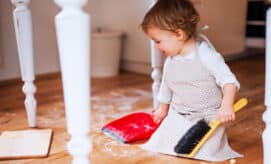As early learning professionals, we set up our classrooms with thoughtful intention, hoping to inspire curiosity, interest, and engagement. In addition to selecting and arranging the materials in our learning environments, we may also consider the specific way that we offer materials to children. Reggio Emilia programs offer materials through “invitations to play”, viewing this process as an opportunity to support children’s playful exploration and investigation.
What is an Invitation to Play?
In its simplest terms, an invitation to play is a specific approach to setting up materials in our classrooms so that children feel inspired to explore, create, and play.
According to Anna Ranson, an early learning educator and author of ECE-focused blog, Imagination Tree, an invitation to play “can be as simple as setting out the tea set and play food on a little table with napkins…or presenting the child with an unusual object for investigation. Most of the time, by placing toys or materials in a new location or presenting them in an original way, the child’s imagination is sparked and they can come to it with fresh eyes and new ideas!”
How Do Invitations to Play Support Development?
An invitation to play encourages children to initiate their own play, which supports a child’s sense-of-self and willingness to exercise independence. When the invitation to play incorporates open-ended materials, it engages a child’s creativity, sense of exploration, and interest in trying new things.
What Does An Invitation to Play Look Like?
Invitations to play can be set up almost anywhere and can include a wide range of materials. Despite this variety, they all share certain characteristics.
-
Items are arranged together in a specific space. In an invitation to play, the materials are all set up together on a tray, small table, or blanket, or in a tub. This encourages creativity as children work together to explore different ways to use the materials.
-
There is little adult direction. When an invitation to play is set up, children are encouraged to explore on their own. Adults offer encouragement, but allow children to take the lead and initiate their own play with the materials.
-
Activities build on children’s interests. When setting up an invitation to play, it is important that we consider the types of play that the children find interesting. For example, if you are working with toddlers, who enjoy sensory experiences, you might set up an invitation that includes playdough or kinetic sand.









